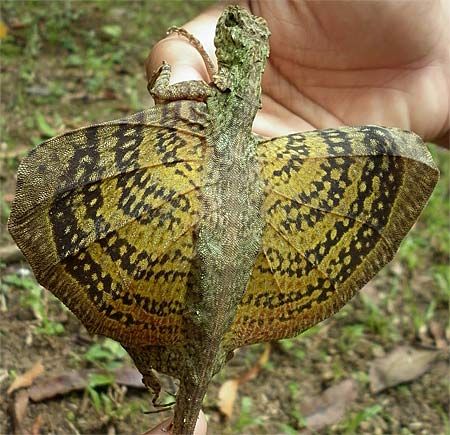Draco is a genus of agamid lizards that are also known as
flying lizards, flying dragons or gliding lizards. These lizards can move by
gliding; their ribs and their connecting membrane may be extended to create
"wings" (patagia), the hindlimbs are flattened and wing-like in
cross-section, and a flap on the neck (the gular flag) serve as a horizontal
stabilizers. Draco are arboreal insectivores.
While not capable of powered flight they often obtain lift
in the course of their gliding flights. Glides as long as 60 m (200 ft) have
been recorded, over which the animal loses only 10 m (33 ft) in height, which
is quite some distance, considering that one of these lizards is only around 20
cm (7.9 in) in total length (tail included).They are found in S. Asia and
are fairly common in forests, areca gardens, teak plantations and shrub jungle.
Reproduction
The only time a female flying lizard ventures to the ground
is when a female is ready to lay her eggs. She descends the tree she is on and
makes a nest hole by forcing her head into the soil. She then lays 2–5 eggs
before filling the hole. She guards the eggs for approximately 24 hours, but
then leaves and has nothing more to do with her offspring.
Species
The following 42 species are recognized:
- Draco abbreviatus Hardwicke & Gray, 1827
- Draco affinis Bartlett, 1895
- Draco beccarii W. Peters & Doria, 1878
- Draco biaro Lazell, 1987
- Draco bimaculatus Günther, 1864
- Draco blanfordii Boulenger, 1885
- Draco boschmai Hennig, 1936
- Draco bourouniensis Lesson, 1834
- Draco caerulhians Lazell, 1992
- Draco cornutus Günther, 1864
- Draco cristatellus Günther, 1872
- Draco cyanopterus W. Peters, 1867
- Draco dussumieri A.M.C. Duméril & Bibron, 1837
- Draco fimbriatus Kuhl, 1820
- Draco formosus Boulenger, 1900
- Draco guentheri Boulenger, 1885
- Draco haematopogon Gray, 1831
- Draco indochinensis M.A. Smith, 1928
- Draco iskandari McGuire et al., 2007
- Draco jareckii Lazell, 1992
- Draco lineatus Daudin, 1802
- Draco maculatus (Gray, 1845)
- Draco maximus Boulenger, 1893
- Draco melanopogon Boulenger, 1887
- Draco mindanensis Stejneger, 1908
- Draco modiglianii Vinciguerra, 1892
- Draco norvillii Alcock, 1895
- Draco obscurus Boulenger, 1887
- Draco ornatus (Gray, 1845)
- Draco palawanensis McGuire & Alcala, 2000
- Draco quadrasi Boettger, 1893
- Draco quinquefasciatus Hardwicke & Gray, 1827
- Draco reticulatus Günther, 1864
- Draco rhytisma Musters, 1983
- Draco spilonotus Günther, 1872
- Draco spilopterus Wiegmann, 1834
- Draco sumatranus Schlegel, 1844
- Draco supriatnai McGuire et al., 2007
- Draco taeniopterus Günther, 1861
- Draco timoriensis Kuhl, 1820
- Draco volans Linnaeus, 1758
- Draco walkeri Boulenger, 1891
Nota bene: a binomial authority in parentheses indicates
that the species was originally described in a genus other than Draco.
Gliding
The lizards are well known for their "display
structures" and ability to glide long distances using their wing-like,
patagial membranes supported by elongated thoracic ribs to generate lift
forces.
In fiction
Draco dussumieri features prominently in Poornachandra
Tejaswi's Kannada novel Carvalho (ಕರ್ವಾಲೊ).
In this story, middle aged scientist Carvalho, searches for this flying lizard
(considered very rare in this novel) in the forests of the Western Ghats in the
Indian state of Karnataka, and finally the lizard flies down a steep cliff off
thick forest. The titular monster from Toho's 1958 film "Varan the
Unbelievable" is based on that of a Draco lizard.



















ReplyDeleteawesome!
Thanks Man :)
Delete